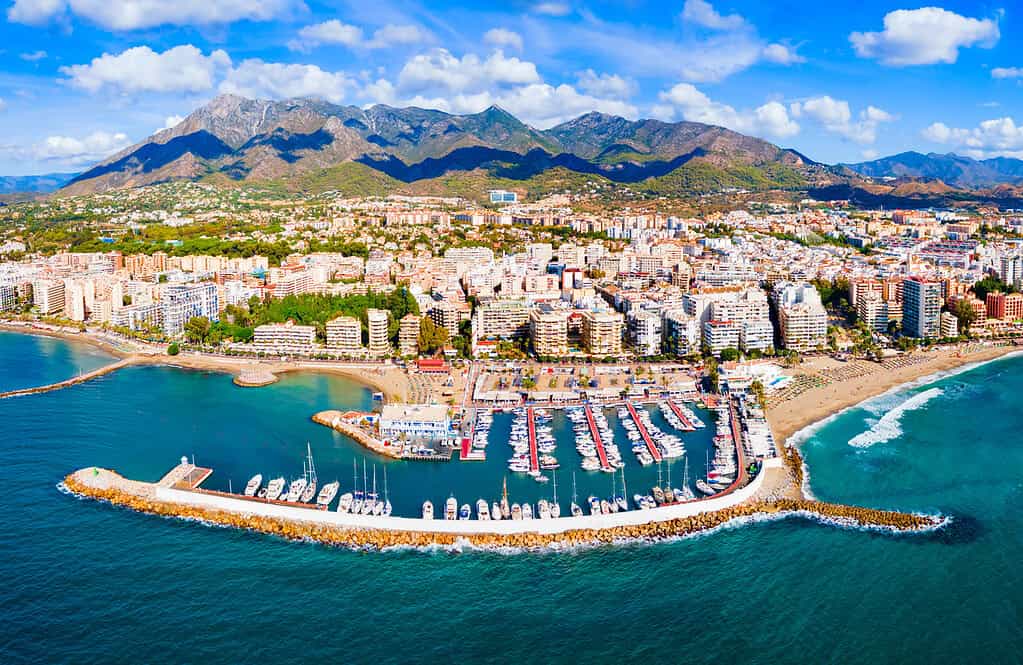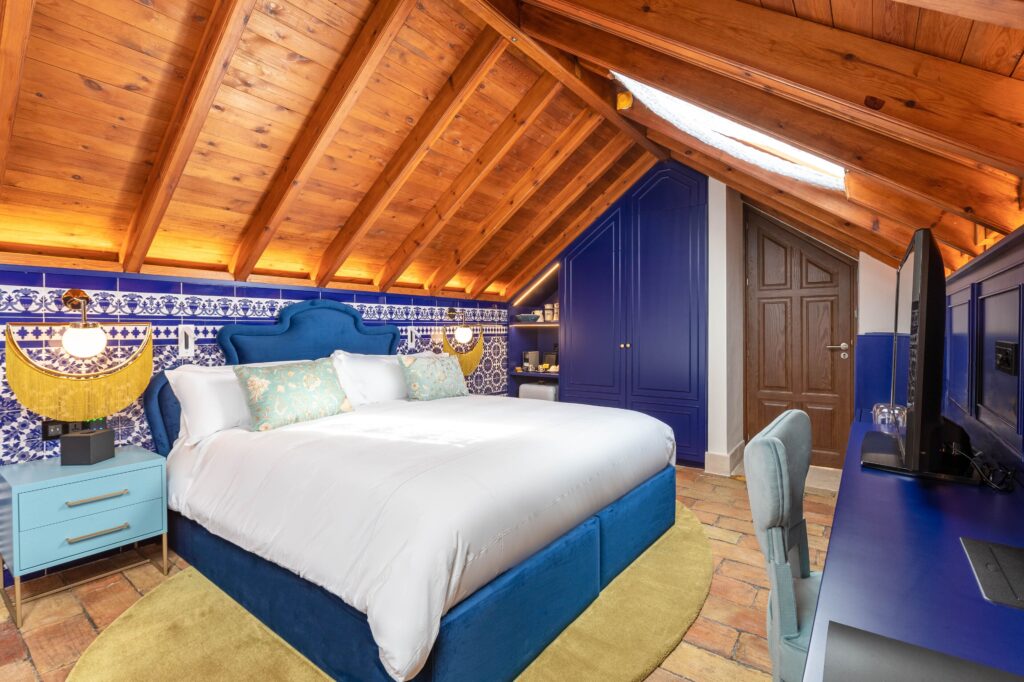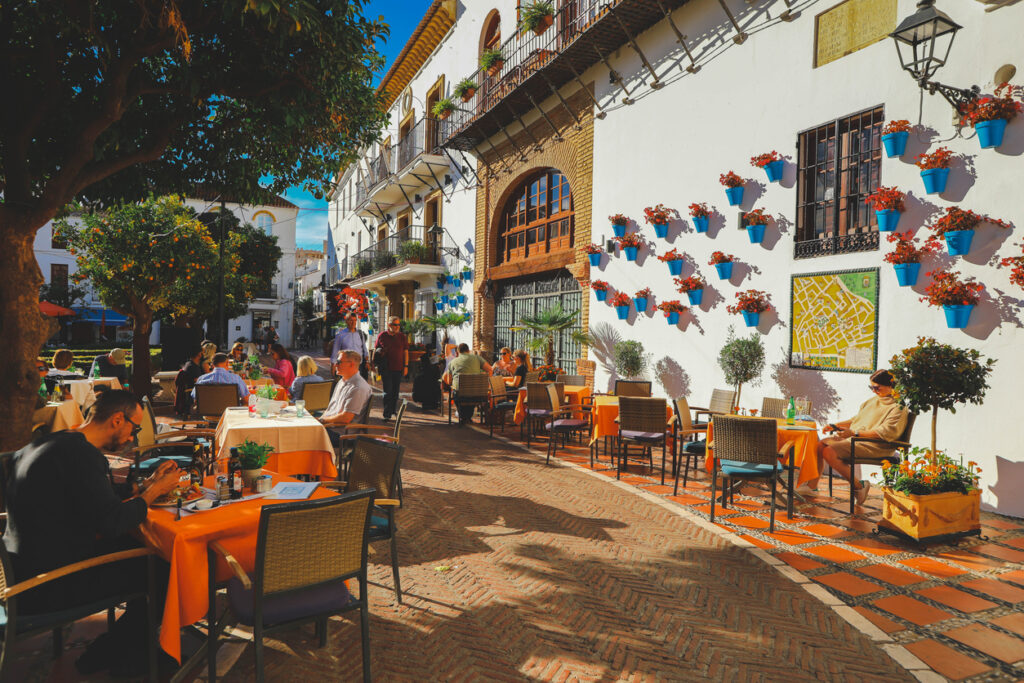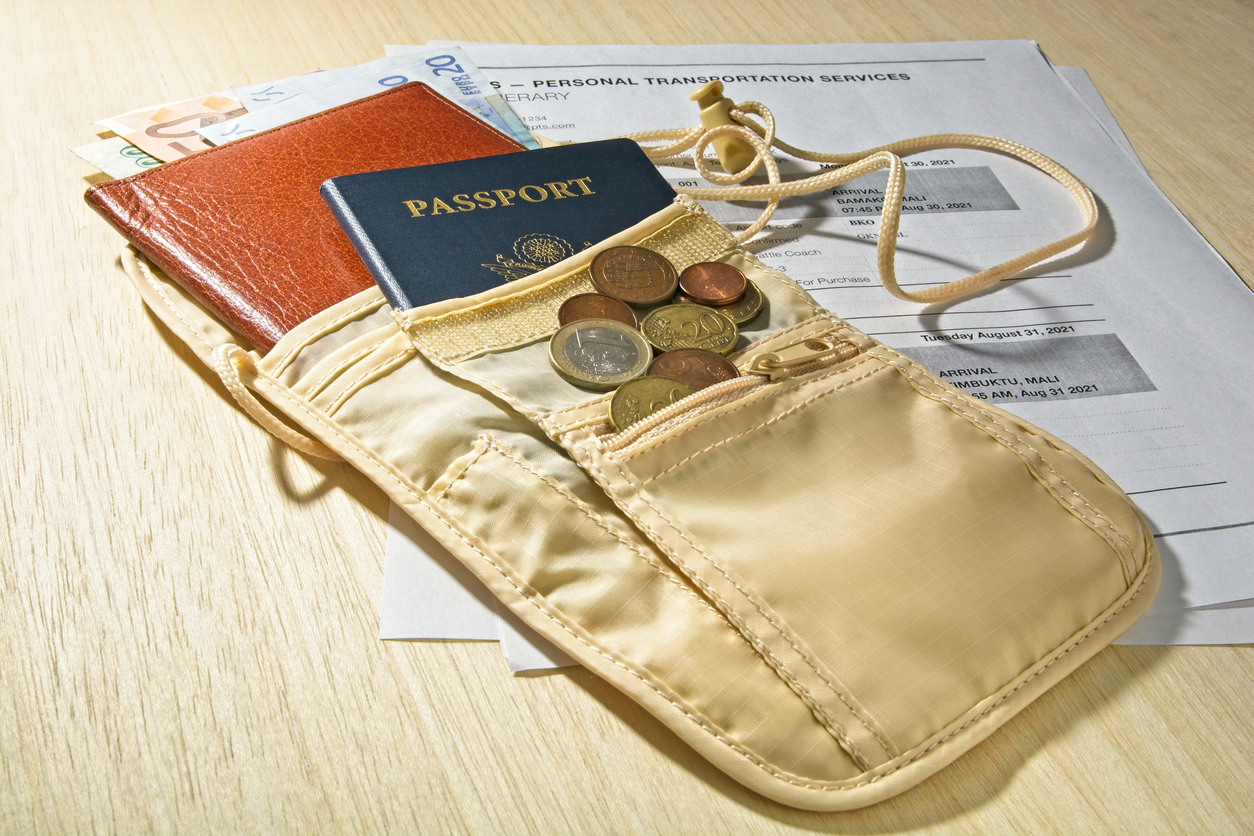Marbella, Spain moves with quiet confidence. Mornings ease in with coffee and sun-warmed stone. By afternoon, the pace slows further—meals stretch long, and shade becomes currency. Evenings invite conversation, sea air, and second glasses of wine.
It’s a place that unfolds steadily, through simple details: tiled rooftops, narrow lanes, and the steady rhythm of coastal life. Spend a little time here, and Marbella starts to feel less like somewhere you’ve arrived, and more like somewhere you’ve slipped into.

*Note some of the links feature affiliate links. I only recommend items that I 100% love and think you will too!
Where is Marbella, Spain—and Why Does It Matter?
Marbella sits along Spain’s southern coast, tucked into a curve of the Mediterranean known as the Costa del Sol. It belongs to Andalusia, but with the sea at its feet and mountains behind, Marbella stands a little apart—geographically and in spirit.
It’s about an hour from Málaga, less than two from Gibraltar, and comfortably wedged between sea-facing promenades and the protective rise of the Sierra Blanca. That geography shapes its weather, its mood, and its rhythm.
- To the north: Sierra Blanca brings shelter and shade.
- To the south: the Mediterranean rolls in, soft and constant.
- To the east and west: coastal roads connect to fishing villages, golf resorts, and other corners of Andalusia.
Knowing where you are here changes how you move. You plan your mornings with the sun, your drives with the coast, your walks with the light.
Getting to Marbella, Spain—and Getting Around Once You’re Here
Most visitors arrive through Málaga–Costa del Sol Airport, which sits just under an hour’s drive from Marbella. From there, you’ve got options. Car hire is easy. So is a direct shuttle or private transfer. You can land at noon and be eating espetos by 2 p.m.
Once you’re in Marbella, movement depends on where you’re staying and how you like to travel. The town is walkable in parts—especially the old quarter and beachside promenades—but spread out enough that a car, bike, or occasional taxi helps.
- By car: Good for flexibility. Worth it if you plan to visit nearby towns or secluded beaches.
- By foot: Best for the casco antiguo and beachfront areas. Quiet alleys and small plazas were built for wandering.
- By bike or e-scooter: Available to rent and handy along the long, flat paseo marítimo.
- By bus: Local routes connect neighborhoods and nearby towns like San Pedro, Estepona, and even Málaga.
Parking can be tricky in summer, especially near the coast. Book a place with a space or be prepared to circle. And if you’re not sure? Walk first. Marbella often rewards a slower approach.
When to Visit Marbella, Spain
Marbella isn’t tied to one perfect season. It shifts, gently, across the year—each stretch offering its own kind of welcome.
Spring and early fall are easiest. The heat hasn’t peaked (or has just passed), the beaches feel roomy, and the evenings stay long. Summer delivers the energy—festivals, late dinners, and sun that lasts past 9 p.m.—but also brings crowds and midday stillness. Winter is mild and quiet. The kind of quiet some people come looking for.
Here’s a quick feel for each season:
- Spring (April to June): Blooming gardens, light breezes, and fewer people.
- Summer (July to August): Busy, bright, full of life. Early mornings and late evenings are your friend.
- Fall (September to October): Sea still warm, streets less crowded, everything slightly softer.
- Winter (November to March): A slower town, cool air, plenty of sun. Good for walks, wine, and calm.
If you like warmth without the rush, aim for May or late September. But even in January, Marbella doesn’t hibernate—it just breathes a little deeper.

Where to Stay in Marbella, Spain—One Boutique Hotel That Gets It Right
If you’re staying in Marbella, and you want charm over flash, Hotel Claude is where to land. Tucked into a quiet corner of the old town, it’s housed in a 17th-century mansion with just seven rooms—each one different, each one designed with care.
The hotel leans into texture: terracotta floors, white linen, soft Andalusian light. There’s a rooftop terrace for slow breakfasts or evening drinks, and you’re a few minutes’ walk from plazas, galleries, and tapas bars that feel lived-in, not staged.
What makes Hotel Claude stand out isn’t just design—it’s pace. It feels like it understands Marbella. It gives you space, quiet, and the kind of service that shows up when needed, then disappears just as smoothly.
- Location: Casco Antiguo (Old Town), walkable to everything.
- Vibe: Elegant, personal, never overdone.
- Extras: Rooftop breakfasts, curated art, staff who know the town well enough to send you to the right beach or the quiet table.
If you want to stay somewhere that feels like Marbella rather than just near it, start here.
Not Finding the Hotel You Want? Use This Map to Find Your Marbella Stay
Sometimes the right place doesn’t show up in a top 10 list. Maybe you’re after a quiet guesthouse near the old town. Or a modern apartment with a kitchen and sea view. Maybe you just want to see what’s nearby and what feels right.
Here’s a live map to help you explore your options. Zoom into neighborhoods, check reviews, compare prices, and find a place that fits how you travel.
Whether you’re looking for elegance on the beach or a tucked-away courtyard room, Marbella has more than one way to stay well.
Wandering Marbella, Spain’s Old Town
Start at the edge—somewhere quiet, like Calle Ancha—and let yourself drift inward. The old town isn’t big, but it folds in on itself: narrow lanes, crooked stairways, whitewashed façades softened by vines and light. You won’t need a map. Just look for orange trees and listen for footsteps.
Plaza de los Naranjos is the center, though it never feels like it’s trying to be. The square holds cafés with iron chairs, flower pots layered onto windowsills, and slow conversation rising above the clink of cutlery. Around it, you’ll find side streets with tiny chapels, bookshops, and houses that look like they’ve been painted that morning.
There’s not much to “do” here, and that’s the point. You’re meant to meander. You’ll pass:
- Iglesia de la Encarnación: a quiet church with a sense of history tucked into its arches.
- Boutiques selling linen, ceramics, and handwoven fans—better souvenirs than anything near the marina.
- Tiled benches beneath jasmine-covered walls, where the sun stops just long enough to warm your back.
Walk slowly. Stop for a café solo. Let the town come to you.
The Coastline of Marbella, Spain—Long Walks and Quiet Swims
Follow the scent of sea air downhill from the old town, and you’ll reach the coast without fanfare. Marbella’s beaches stretch east and west—some polished and buzzing, others quiet and low-key—but all framed by the same soft light and steady sound of waves.
The paseo marítimo is your starting point. It’s a palm-lined promenade running for miles beside the sea, dotted with chiringuitos (beach bars), benches, and the occasional stray cat sunbathing like a pro. Walk it in the morning when it’s still cool, or late in the day when the sun starts to lean.
If you’re here to swim or just sit close to the water, a few beaches stand out:
- Playa de la Fontanilla: Central and easy, with loungers, cafés, and a friendly pace.
- Playa de Nagüeles: A bit further along the Golden Mile—clean, soft sand, and space to breathe.
- Cabopino Beach and Dunas de Artola: More natural, less crowded, with protected dunes and a wilder feel.
Bring a towel, a book, and no schedule. The coast in Marbella works best when you let it shape your day, not fill it.

Eating in Marbella, Spain—Sea, Salt, and Second Helpings
Food in Marbella follows the light. Lunch happens late. Dinner even later. And the best meals often start unplanned—stumbling into a shaded terrace or following the scent of grilled fish drifting down a side street.
Local flavors lean Mediterranean with strong Andalusian roots. Think seafood, olive oil, tomatoes that taste like summer, and bread that never needs butter. Tapas are everywhere—but not all are created equal. Skip the plastic menus. Look for napkins on the floor and conversations that lean in.
A few essentials to try:
- Espeto de sardinas: Sardines grilled over open flame, often served on the beach. Smoky, simple, perfect.
- Salmorejo: A thicker cousin of gazpacho—cold, creamy, topped with jamón and egg.
- Pescaito frito: Lightly fried fish, best shared with a cold glass of manzanilla.
- Churros with chocolate: If you’re up early or still out late, this is the move.
Where to go? Skip the marina unless you’re paying for the view. The old town has tucked-away spots that serve meals with history, not just flair. And always ask locals—Marbella is full of proud regulars who know where the real food lives.
Want some help? Try this Marbella Old Town tapas food tour.
Easy Day Trips from Marbella, Spain
Marbella is well-placed—close to mountains, tucked along the coast, and near some of Andalusia’s most compelling towns. If you have a car or don’t mind the bus, a few nearby escapes are worth carving time out for.
These aren’t checklists—they’re changes of pace:
- Ronda: Built on both sides of a deep gorge, connected by a stone bridge that feels improbably placed. Whitewashed streets, bullfighting history, and that cliff-edge view. Go for lunch. Stay for sunset.
- Mijas Pueblo: Compact, hilly, and painted entirely in white. It has the feel of a place that knows how to host without trying too hard. Take the slow road up.
- Benahavís: A short drive inland. Known for food, but also for its peaceful streets and mountain air.
- Estepona: Less polished than Marbella, more local, and full of murals and secret cafés. If you want a change of texture—not just scenery—it’s a good half-day wander.
- Caminito del Rey: A narrow path clinging to the cliffs above a gorge. For walkers with a head for heights and a love of views that earn themselves.
Start early, especially in summer. Come back by evening, when Marbella starts to hum again.
Culture and Festivals in Marbella, Spain
Marbella doesn’t shout about its traditions—but they’re there, tucked between modern villas and beachfront restaurants. If you time it right, or even stumble into it, you’ll find a town that still honors its roots.
The calendar moves in waves here. Big events, quiet rituals, and things that locals take seriously—even if tourists don’t always notice.
What to look out for:
- Feria de San Bernabé (June): Marbella’s main festival. Horse parades, flamenco, food tents, and dancing that lasts until sunrise. Go with someone who’s been before—or just follow the music.
- Semana Santa (Holy Week): Traditional processions in the lead-up to Easter. Slower, more somber, but deeply moving. Even if you’re not religious, the weight of it carries.
- Summer concerts and jazz nights: Often held in outdoor venues or plazas. Music under the stars, local wine in hand.
- Local markets: Weekly markets selling antiques, produce, and crafts. Not flashy—but full of texture.
The cultural side of Marbella is quieter than in Seville or Granada, but that’s part of its rhythm. It offers space to engage on your own terms, without a script.
Nightlife in Marbella, Spain—Late Light and Easy Laughter
Evenings in Marbella start slowly. A stroll, a drink, a table that turns into a second round without much effort. There’s no pressure here to “go out.” The night comes to you.
The old town is full of places that feel like secrets—even when they’re full. Wine bars with candles flickering in alcoves. Rooftop terraces where the breeze gets caught in your hair. Restaurants that turn into conversations long after the plates have cleared.
If you want more energy:
- Puerto Banús: flashier, louder, designed for nightlife. Think DJs, bottle service, and yachts. It’s not for everyone—but for some nights, it fits.
- Paseo Marítimo: calmer, lined with bars that face the sea. Great for a quiet drink and the sound of waves instead of music.
- Flamenco nights: sometimes tucked into hotel courtyards or small bars. Raw, powerful, and far better than the big-ticket shows aimed at tourists.
- Live music in old-town taverns: smaller spots host local guitarists or jazz sets that pair well with red wine and not much else.
You won’t need a plan—just shoes good enough for cobblestones and an appetite for staying up a little later than usual.
Marbella, Spain—You’ll Know It When You Feel It
Marbella doesn’t try to impress. It doesn’t need to. What it offers is steadier than that—a certain light at dusk, the clink of coffee cups in a quiet plaza, the way time stretches when you stop checking your watch.
It gives you options: slow beach days or day trips into the hills, barefoot afternoons or well-set tables at midnight. And it does all this with a kind of calm confidence that’s rare along this coast.
You could come here once and call it done. Or you could come back the way many do—quietly, without fuss, because something about it fits. Not perfectly. Just enough to make you want to stay one more day.
And honestly? That’s more than enough.
FAQ’s About Marbella, Spain
What is special about Marbella, Spain?
Marbella blends Mediterranean calm with Andalusian charm. Its old town is full of whitewashed streets and orange trees, while its coastline offers long promenades, natural beaches, and fresh seafood. Add in mountain views, mild weather, and a steady cultural rhythm, and you get a town that quietly draws people back.
Is Marbella in Spain expensive?
Marbella can be pricey—especially along the Golden Mile and Puerto Banús—but it’s also possible to visit without overspending. Boutique hotels, local tapas bars, and public beaches offer good value. It all depends on how you travel.
Which is better, Málaga or Marbella?
Málaga is larger, with museums, a bustling port, and more urban energy. Marbella is smaller, calmer, and more coastal in feel. If you want art and city life, choose Málaga. If you prefer quiet walks, beaches, and a slower pace, Marbella fits better.
Is Marbella for partying?
Yes, but not only. Marbella has a party scene—especially in Puerto Banús—but much of the town runs on quieter energy: long dinners, beach walks, and relaxed nights out. It works just as well for those who want calm over clubs.
Spain Packing List
Explore expert-curated guides on the best travel accessories, noise-canceling headphones, essential safety items for solo female travelers, stylish outfit ideas for Spain, and top deals on travel gear in 2025, ensuring a seamless and well-prepared journey.
The Best Noise Cancelling Headphones for Airplane Travel
Find the best noise-canceling headphones for airplane travel, offering superior comfort, sound quality, and battery life for a peaceful journey.
The Essential Safety Items for Solo Female Travelers
Discover the essential safety items for solo female travelers to stay secure, confident, and prepared on any journey.
The Ultimate Guide to the Best Travel Accessories in 2025
Explore the ultimate guide to the best travel accessories in 2025, featuring must-have gadgets and gear for a seamless and comfortable trip.
Essential Travel Gadgets for Women: The Must-Have Tools for a Seamless Trip
Discover the essential travel gadgets for women, featuring must-have tools to enhance convenience, security, and comfort for a seamless trip.
Prime Big Deal Days: The Best Travel Gear and Deals for 2024
Discover the best travel gear and deals for 2024 during Prime Big Deal Days, featuring top discounts on must-have essentials for your next trip.
Disclaimer: The content on Must See Spain is provided “as is” with no guarantees of accuracy, reliability, or suitability. Travel involves risks, including injury, illness, theft, or unexpected events. Must See Spain is not responsible for any issues encountered during your travels. Always verify information independently and check local sources before making plans.




Be the first to comment